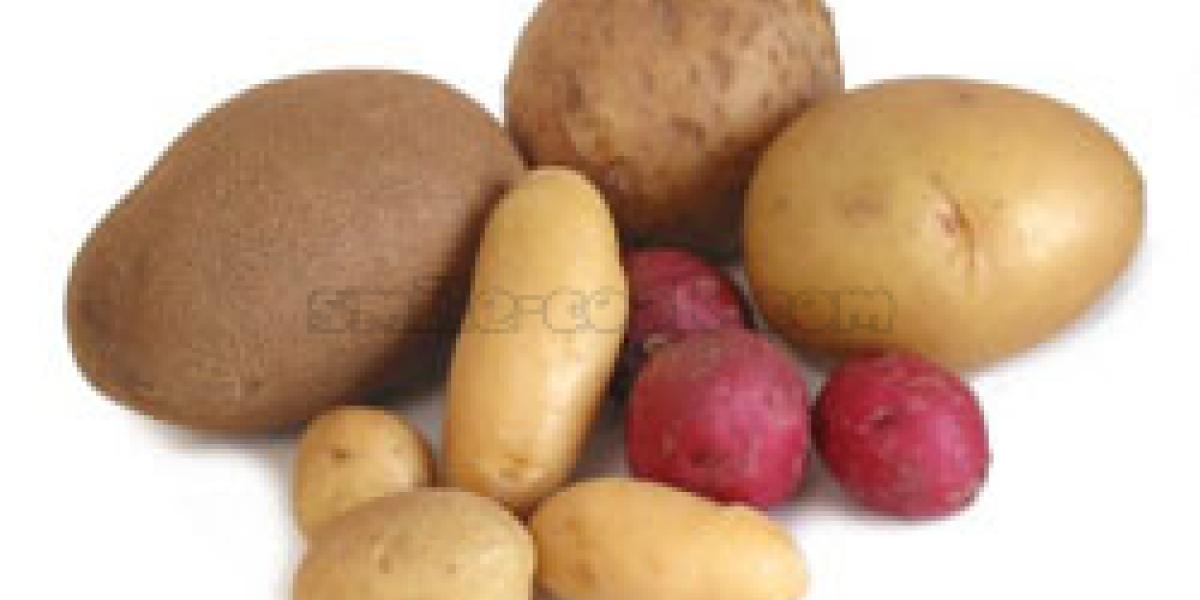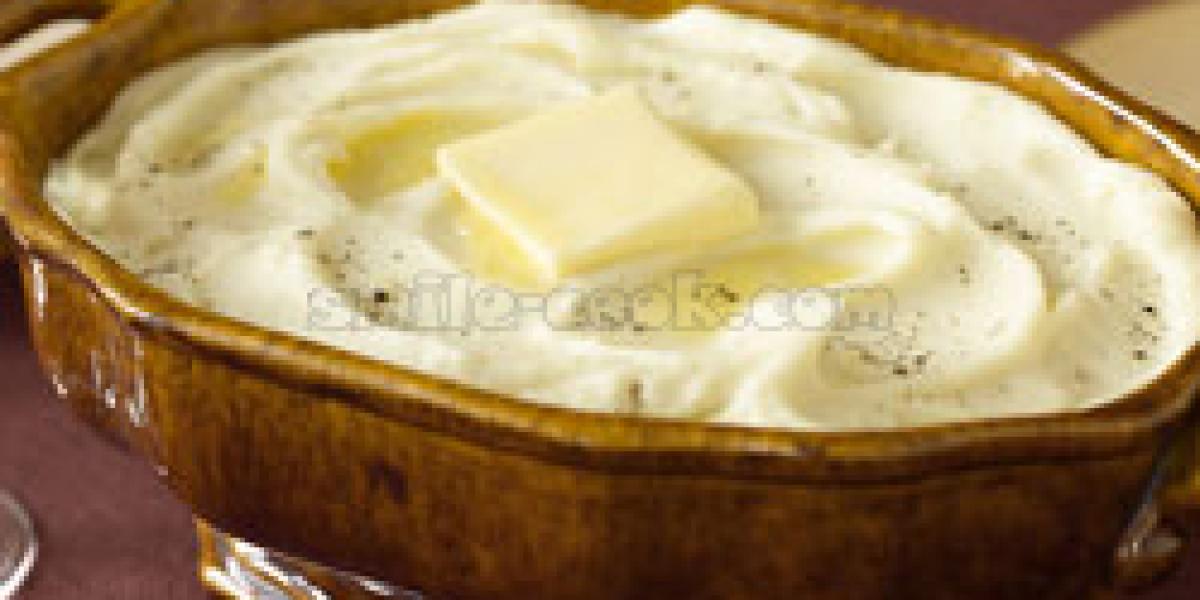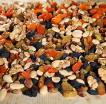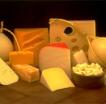A few facts about potatoes. Rules and recipes for cooking potato dishes.
Potatoes, or potatoes as they are affectionately known, are a versatile product from a culinary point of view, and there are many ways to use and prepare them. They can be boiled in water, steamed, fried in all kinds of oils and fats, stewed and baked. And each new type of processing gives potatoes a new flavor, which allows you to create a wide variety of potato dishes.
 In addition to processing, the form of its cutting and the method of cooking also influence the taste of potatoes and its changes: baking and boiling in the jacket (skin) and whole in peeled form, in the form of plaques, bars, straws, in the form of mashed potatoes and raw potatoes.
In addition to processing, the form of its cutting and the method of cooking also influence the taste of potatoes and its changes: baking and boiling in the jacket (skin) and whole in peeled form, in the form of plaques, bars, straws, in the form of mashed potatoes and raw potatoes.
One of the main quality indicators of potatoes — the degree of starch content: the higher it is, the crisper the variety and tastier the dish made of it. Therefore, potatoes should not be soaked (washed) long before cooking, keep long peeled in water, as it leads to the leaching of starch.
The main requirement for potato dishes — that they should be served hot, immediately after cooking, otherwise potatoes harden (this property is sometimes used when cooking fast boiling potato varieties).
The only restriction when cooking potatoes: they should not be combined with sour environment, acidic products, as in this case they harden, delay the cooking of the whole dish and lose all their positive qualities.
That's why in order that potatoes don't harden when boiling sauerkraut soup, cut pieces of potatoes are boiled for 10 minutes beforehand, putting them into salted boiling water. Then the water is drained and put potatoes in boiling sour cabbage soup.
In addition, it is not allowed to leave and reheat potato dishes.
Some rules for proper cooking of potatoes.
It's important to know how to properly cook potatoes and certain potato dishes.
It's important to know how to cook potatoes and certain potato dishes.
For example, Boiled Potatoes. When large tubers are boiled, their top layers are overcooked before the flesh in the center reaches doneness. Therefore, large tubers are cut.
Boil potatoes (peeled or in "jacket) on steam or immerse them in boiling salted water and cook at a low boil with a lid on.
If potatoes are immersed in cold water, the temperature inside the tubers reaches 70°C only after 20-25 minutes. During this time more than 10% of starch can be saccharified; the resulting sugar will partially pass into the water.
When potatoes are immersed in boiling water, the enzymes lose their activity after 5-b minutes, starch hydrolysis practically does not occur and the loss of nutrients is significantly reduced. At this method of cooking faster inactivated and enzymes that oxidize vitamin C.
In the process of cooking potato starch is glued due to the moisture of cell juice, so water is not absorbed from the external environment, the weight of tubers practically does not change. There is only a slight decrease in it, which is explained by the evaporation of moisture from the surfaces of tubers after draining the water. Kleisterized starch fills the cells of the potato tuber, and glue does not flow out of them. Therefore, in boiled potatoes you do not feel stickiness.
In the process of cooking, the protopectin of the middle plates connecting the cells is hydrolyzed and transformed into soluble pectin, the connection between the cells is weakened and the potato becomes crumbly.
Some varieties of potatoes are very boiled, the tubers are deformed. In these cases you can add a little vinegar or citric acid, lemon juice to the water. In an acidic environment, the breakdown of protopectin slows down and potatoes do not boil, harden. Often, boiling in slightly acidified water is used in the preparation of potatoes for salads, so that the potatoes became harder, and in the salad pieces did not fall apart.
When the potatoes are boiled, the water is immediately drained, and the potatoes are dried by covering the pot with a lid at very low heat. In this case, the remaining moisture from the surface of the tubers partially evaporates, and partially absorbed by the starch of the potatoes.
Boiled potatoes are served with butter, onions fried in fat, sour cream and sour cream, mushroom, béchamel sauces.
When serving sprinkle with chopped herbs - more often dill and parsley, less often cilantro, basil, etc. to taste.
And sprinkle with potatoes.
Potatoes in milk. Potatoes boil badly in milk, so they are cut into slices or cubes and boiled for 10 minutes in water, after which the water is drained, pour hot milk potatoes and cook until ready. When serving, put a piece of butter on the dish.
Fried Potatoes. Potatoes are cut into bars, wedges, slices and cubes. Then, to avoid sticking to the pan, the pieces are rinsed in cold water and dried with a towel. After drying, in order to completely avoid sticking, it is recommended to roll potato pieces in a mixture of wheat flour and egg powder (it is possible only in flour, but in a mixture of flour and egg powder 1:1 is tastier). Sometimes boiled potatoes are also fried. To do this, it is boiled in the jacket (shortly before frying or in advance), then peeled, let a little dry, cut into slices or thick circles and fried. To avoid sticking it is recommended before frying to roll them, as well as raw potatoes, in a mixture of wheat flour and egg powder. .
Potatoes fried in fat (deep-fried). Potatoes are cut into bars, straws, cubes, slices. Cut potatoes before frying rinse with cold water and then dry. This contributes to the formation of an even crust and prevents potato pieces from sticking together during frying, but increases the loss of nutrients. It is not allowed to salt potatoes before frying, as it causes their soaking and strong absorption of fat. To prepare potatoes bloated (soufflé) it is cut into circles 3-4 mm thick, immersed, first in fat, heated to 120-130°C, lightly fried without browning. In this case, the starch in the surface cells kleisteriziruetsya and forms a thick crust. After that potatoes are immersed in fat heated to 180°C, the moisture inside the tuber turns into steam and the potatoes puff up. To prepare crispy potatoes (chips) use varieties containing at least 22% of dry matter and 1.5% of reducing sugars. Potato crackers. To prepare them, starch is added to mashed potatoes, the mass is released from a conical nozzle, cut into plates and dried. Potato Cakes. Boiled and dried potatoes are mashed, slightly cooled (up to 55—60°C) and mixed with raw eggs. From the mass form cutlets, giving them an oval shape with one pointed end, products breaded in flour, then in leeson (egg, beaten with 1-2 tablespoons of milk), then in breadcrumbs and fried. Lightly sauteed onions can be added to the cutlet mixture. Potato Zrazy. Mass for zrazy prepared in the same way as for potato cutlets. Stuffing is prepared from sauteed onions, chopped boiled mushrooms and chopped eggs. You can prepare mincemeat and from poached carrots, onions and mushrooms or only from pasted onions. From the potato mass form a round cake, put minced meat in the middle, wrap the edges, bread it in breadcrumbs or flour and fry on both sides in a frying pan with fat. Potato croquettes. Potatoes are peeled, boiled and dried. Hot potatoes rubbed, add eggs mixed with butter or margarine. From the resulting mass form small balls, pears (4—6 pcs. per serving). They are breaded in flour, soaked in eggs (or leeson) and breaded in grated wheat bread or breadcrumbs. Potatoes Stewed. Cut potatoes into cubes, fry them, pour red or tomato sauce and stew; at the end of the stew, add sauteed onions. You can add fried mushrooms. When serving you can put fried tomatoes together with potatoes.
 Mashed potatoes. Boiled and dried potatoes are mashed very hot (not below 75-80°C), add butter, in 2-3 steps pour in hot (almost boiling) milk and thoroughly whipped to a lush mass.
Mashed potatoes. Boiled and dried potatoes are mashed very hot (not below 75-80°C), add butter, in 2-3 steps pour in hot (almost boiling) milk and thoroughly whipped to a lush mass.
Whipping of mashed potatoes is obligatory, although many people do not perform this procedure, which leads to a significant decrease in the taste of mashed potatoes.
In order to delay hardening of mashed potatoes when cooling, it is necessary to add not only hot milk (or hot cream) and butter, but also fresh eggs (it is better only yolks), and vegetable oil (refined sunflower or olive oil; from half the amount of added butter to an equal amount) when cooking (i.e. in a very hot state). This helps to preserve both the flavor and consistency of mashed potatoes.
Mashed potatoes are used as an independent dish and as a garnish to meat and fish dishes. When serving on the surface of mashed potatoes with a knife or a spoon draw a picture and put a piece of butter.
When rubbing hot potatoes, the cells of its tissues remain intact, glue does not flow out of them and the mashed potatoes are not made sticky. When the potato is cooled, the pectin hardens, glues the cells, the shells of which break when rubbed, the glue leaks out and the mashed potatoes become unpleasantly sticky.
Fry, stirring, in a hot pan with oil. Salt the potatoes after the formation of a ruddy crust. The layer of potatoes should be no higher than 4-5 cm - the thinner the layer of potatoes, the easier and simpler it is to fry.
If the potatoes are not cooked through when frying (it happens when the layer is too thick), they should be fried in a frying cabinet.
Fat consumption is about 7% of the weight of peeled raw potatoes. In the process of frying due to evaporation of moisture, the potato decreases in mass - raw potatoes by 31%.
During cooking most of the moisture is absorbed by starch, so its evaporation is hampered, the loss of potato weight is reduced almost twice (17%). Fat consumption in this method of frying increases, because after absorption of moisture by starch, fat absorption increases.
Serve fried potatoes, pouring fat and sprinkling with herbs, with pickles, tomatoes, pickled mushrooms, cabbage salads, etc.
For frying it is better to use frying fats (the best is a mixture of refined and deodorized sunflower oil and melted pork fat 1:1), but nowadays only refined vegetable oil is more often used, which also gives excellent results.
The fat is heated to 180-190°C. It should fill the dish only half of its capacity. The mass of potatoes should be 8-10 times less than the fat, but not more than 1:4. After the formation of a ruddy crust, the potatoes are removed and immersed for frying a new batch. The fried potatoes are placed in a colander for fat drainage and sprinkled with salt powder.
Fat consumption is 8% (weight of raw peeled potatoes). Frying rate for potatoes fried in slices is 36%, bars (fries) - 50%, straws (pai) - 60%.
It is not recommended to fry potatoes until the crust darkens too much - this leads to a sharp decrease in the flavor of the dish and to overheating (overheating and spoiling) of the fryer.
With proper frying, the fryer can be used many times without reducing its quality.
For deep frying, it is recommended that two stainless steel pans be set aside specifically for frying: a larger one for frying and a smaller one for storing the fryer. After cooking the potatoes in the larger pot, the red-hot fryer should be completely drained from the product through a loose lid into the smaller pot, where it should be allowed to cool down and placed in the refrigerator.
The next time the fryer is cooked, carefully drain the fryer into the larger pot, leaving a sediment at the bottom of the smaller pot (so we eliminate the procedure of filtering the fryer).
And so many times. Grease drips, formed during draining on the outer surface of the pans, at once thoroughly wipe with paper napkins.
It is not necessary to wash a large pan after draining the fryer from it - it should be done only when the pan is too greasy on the outside or has not been used for a long time and, of course, every time you replace the used fryer with a new one. If you pour no more than 1/3 of the fryer in a large pan, you will not have to do this often (i.e. you should take a bigger frying pan).
In this way, you will always be ready to cook french fries quickly and without hassle.
Since it is difficult to measure the temperature of oil at home, simply heat up the fryer on high heat and fry on the same high heat, carefully watching only the color of the fried product.
Once the product is ready, do not leave it to cool in the heated oil for a second, otherwise the product will begin to soak in oil (salty). When the product is ready, either remove it from the fryer without turning off the fire and put in a new portion for frying, or remove it from the fire and immediately drain the oil completely from the product.
When frying french fries, you can also put in large onions cut into large rings at the same time - the potatoes will be even more delicious, and browned fried onions will be a great addition to the dish.
Experts point out that dishes properly deep-fried in a good fryer are just as dietary as boiled ones.
This provision in no way applies to industrially fried products, where as a fryer - to increase its thermal stability and term of use (a week of continuous round-the-clock frying in the same fryer) - use fats that are fundamentally inadmissible in human and animal nutrition. As people joke, they fry on "sovka oil" - even cockroaches and flies don't eat these fats (they don't eat margarine either - flies don't even sit on it).
Self-made potato chips are an excellent dietary product, including for children's food. And chips from the store - unacceptable poison.
Potatoes fried in fat (deep fryer) can be cooked to semi-cookedness, cooled or frozen. Frozen French fries are also produced in this way. Before use, they are cooked in a fryer or in fat in a frying pan, which is convenient for quick cooking.
Potatoes fried in fat are served as a side dish or an independent dish, sprinkled with herbs.
Potatoes fried with straws are placed in a mound on a plate or a dish covered with a paper napkin.
Peeled potatoes are cut into very thin slices (usually 1-1,5 mm, in classical English cooking – 4 mm - so tastier), rinsed, thoroughly dried with a napkin and deep-fried at 170-180°C.
Take the chips out of the fryer, let the fat drain off and sprinkle with salt powder.
Dried crackers are well preserved in the refrigerator. Before serving, crackers are fried for a few seconds in fat and served as a side dish. They are convenient for quick preparation.
Cutlets are served with butter, sour cream and sauces (sour cream, onion, tomato, mushroom, béchamel). The cutlets are placed on the dish so that the sharp end of the cutlet covers half of the wide end of the other one.
Zrazy (two per serving) are placed on a melchior dish or a plate. Sour cream, tomato, mushroom or red sauces are served separately or poured on the dish.
Croquettes are fried in fryer and served with tomato, mushroom, onion or red sauce with onions and gherkins.



